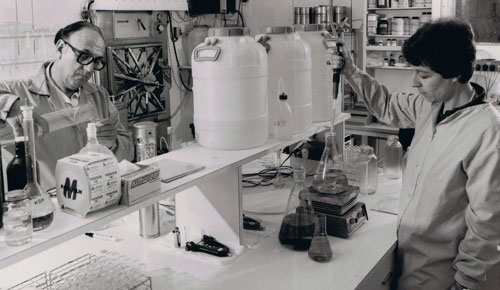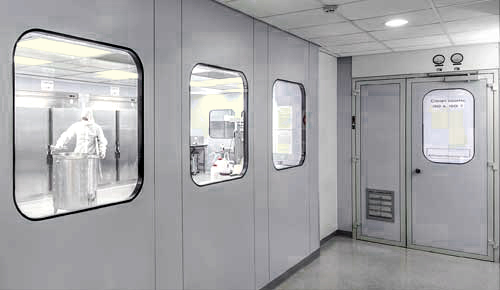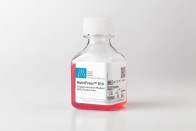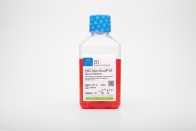Description
Details
Product Overview
MSCgo™ Osteogenic Differentiation Medium is a serum-free (SF), xeno-free (XF), complete, and ready to use formulation developed for optimal differentiation of human mesenchymal stem cells (hMSC) to mature osteocytes. The MSCgo™ Osteogenic Differentiation Medium is validated to efficiently differeniate hMSC from a variety of sources, including bone marrow (BM-MSC), adipose tissue (AT-MSC), and umbilical cord tissue (UC-MSC).
The MSCgo™ Osteogenic Differentiation protocol is part of a complete system for multipotency evaluation of hMSCs. The MSCgo™ Osteogenic Differentiation Medium enables reliable osteogenesis if hMSCs. Differentiation to mature osteocytes is seen between 14 and 21 days.
Features
- Serum-free, xeno-free solution
- Complete differentiation medium
- Ready-to-use, simple protocol
- Reliable differentiation to mature osteocytes
- Contains stable L-alanyl-L-glutamine
- Does not contain antibiotics
Osteogenesis Results
Osteogenic differentiation of hMSC results in the formation of mineralized culture with calcified nodules and calcium secretion that can be detected with Alizarin Red S (ARS) staining. The ARS is used to stain calcium deposits formation which are an indication of mature osteocytes. The amount of calcified nodules formation and calcium secretion can be varying using different hMSC (e.g. source, age, and passage number).
Specifications
Specifications
| QTY | 100 mL |
|---|---|
| Brand | MSCgo™ |
| Storage Conditions | 2 to 8°C |
| Shipping Conditions | Cold Pack |
| Quality Control | The MSCgo Osteogenic Differentiation Medium is validated for optimal differentiation of hMSC into osteocytes. Additional tests are: pH, osmolality, endotoxins and sterility tests. |
| Specifications | Required Materials for Osteogenic Assay
|
| Legal | For human ex vivo tissue and cell culture processing applications. This reagent is not approved for human or animal use, or for application of in vitro diagnostic procedures. |
References
references
- D. Kamiya et al. Induction of functional xeno-free MSCs from human iPSCs via a neural crest cell lineage. npj Regenerative Medicine, 2022
- W. Zhou et al. Autophagy inhibition restores CD200 expression under IL-1β microenvironment in placental mesenchymal stem cells of fetal origin and improves its pulmonary fibrosis therapeutic potential. Molecular Immunology, Volume 151, November 2022
- Q. Deng et al. Osteogenic Differentiation of Human Umbilical Cord Blood Mesenchymal Stem Cells Induced by Liu’s Zhenggudan No. 2 Formula. Evidence-Based Complementary and Alternative Medicine, vol. 2022
- V.P. Mantripragada and G.F. Muschler Improved biological performance of human cartilage-derived progenitors in platelet lysate xenofree media in comparison to fetal bovine serum media. Current Research in Translational Medicine, 2022
- S. Cai et al. Single-cell RNA sequencing reveals the potential mechanism of heterogeneity of immunomodulatory properties of foreskin and umbilical cord mesenchymal stromal cells. Cell & Bioscience volume 12, Article number: 115 (2022)
- X. Kang et al. . Zuogui Wan slowed senescence of bone marrow mesenchymal stem cells by suppressing Wnt/β-catenin signaling. Journal of Ethnopharmacology, 2022
- N.I. Enukashvily, et al., Pericentromeric Non-Coding DNA Transcription Is Associated with Niche Impairment in Patients with Ineffective or Partially Effective Multiple Myeloma Treatment. International Journal of Molecular Sciences, 2022
- X. Zhang, et al. Human umbilical cord mesenchymal stem cell-derived exosomal microRNA-148a-3p inhibits neointimal hyperplasia by targeting Serpine1. Archives of Biochemistry and Biophysics, Volume 719, 2022
- V.A. Nikitina, et al. Cytogenetic Characteristics of Diploid Lines of Mesenchymal Multipotent Stromal Cells. Cell Tiss. Biol. 15, 604–615 (2021). https://doi.org/10.1134/S1990519X21060146
- J. Wang, et al. Trehalose glycopolymers for cryopreservation of tissue-engineered constructs. Cryobiology, 2021, https://doi.org/10.1016/j.cryobiol.2021.11.004.
- A.V. Kotova, et al. Comparative Analysis of Dental Pulp and Periodontal Stem Cells: Differences in Morphology, Functionality, Osteogenic Differentiation and Proteome. Biomedicines 2021. https://doi.org/10.3390/biomedicines9111606
- C. Siyu, et al. Single Cell Transcriptome Sequencing Reveals the Potential Mechanism of Heterogeneity in Immunoregulatory Function Between Mesenchymal Stromal Cells. research square 2021, DOI: https://doi.org/10.21203/rs.3.rs-823639/v1
- Y. Matsuo, et al. Isolation of adipose tissue-derived stem cells by direct membrane migration and expansion for clinical application. Human Cell (2021). https://doi.org/10.1007/s13577-021-00505-3
- Y. Matsuo, et al. Isolation of adipose tissue-derived stem cells by direct membrane migration and expansion for clinical application. Human Cell (2021). https://doi.org/10.1007/s13577-021-00505-3
- Y. Galat, et al. Crispr editing of the gli1 first intron abrogates gli1 expression and differentially alters lineage commitment. Stem Cells, January 2021, https://doi.org/10.1002/stem.3341
- S. Kikuchi, et al. Development of a nasal mucosa-removal model for evaluating cell therapy. Regenerative Therapy, Volume 16, 2021, P. 32-41, ISSN 2352-3204, https://doi.org/10.1016/j.reth.2020.12.004.
- J. Min, et al. Phenotype and biological characteristics of endometrial mesenchymal stem / stromal cells:A comparison between intrauterine adhesion patients and healthy women. AJRI, 18 November 2020, https://doi.org/10.1111/aji.13379
- R. Moloudi et al. Inertial-Based Filtration Method for Removal of Microcarriers from Mesenchymal Stem Cell Suspensions. Scientific Reportsvolume 8, Article number: 12481 (2018)
- J.K. Ledwon et al. Osteogenic Differentiation Of Msc As A Model Study Of The Postnatal Progressive Crouzon Syndrome. Plastic and Reconstructive Surgery - Global Open. 6(4S):116, APR 2018
- L. Sun et al. Human gastric cancer mesenchymal stem cell-derived IL15 contributes to tumor cell EMT via up-regulation of Tregs ratio and PD-1 expression in CD4+T cell. Stem Cells and Development, 2018
- J. Leber et al., Microcarrier choice and bead-to-bead transfer for human mesenchymal stem cells in serum-containing and chemically defined media. Process Biochemistry, volume 59, Part B, August 2017, Pages 255-265
- L. Pu et al., Compared to the amniotic membrane, Wharton’s jelly may be a more suitable source of mesenchymal stem cells for cardiovascular tissue engineering and clinical regeneration. Stem Cell Research & Therapy 2017 8:72
- M. Meng et al., Umbilical cord mesenchymal stem cell transplantation in the treatment of multiple sclerosis. American Journal of Translational Research, 2018;10(1):212-223
Documentation
Materials Safety Data Sheet
Manuals and Protocols
Product Literature
Certificate of Analysis
COA's can be downloaded from Sartorius's Certificates Portal.
For certificates issued before November 15, 2021, please enter below the product lot number and click search.







